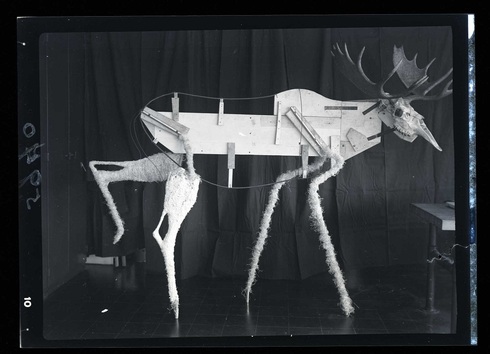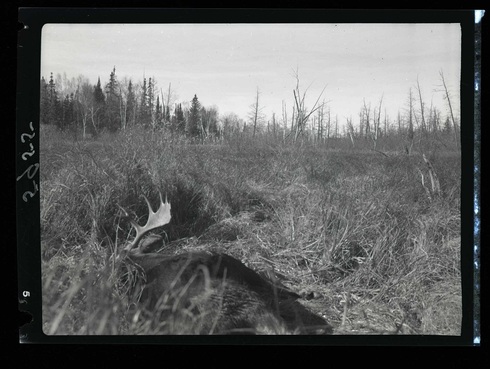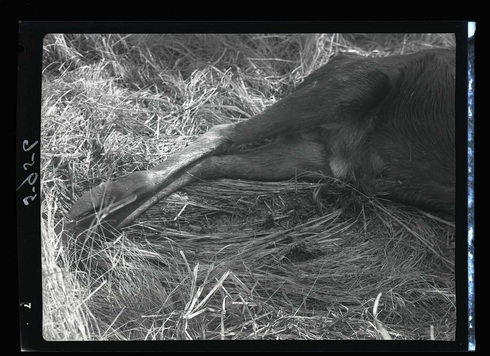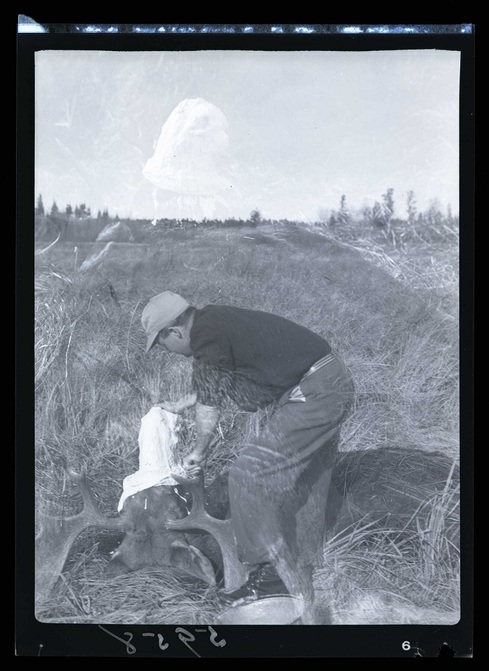For several months now I have wanted to share some unique images from the Bell Museum of Natural history negative collection. The images document the preparation and construction of the iconic Bell Museum dioramas, or what museum director Thomas Sadler Roberts referred to as “habitat groups,” a common term in the early 20th century to describe the display of mounted zoological specimens arranged in a scene that replicates the natural environment.
Each time I attempt to write about the dioramas I get mired down by the complex and detailed history of taxidermy and museum exhibition techniques. Then I realized that the best person to introduce taxidermy is the taxidermist – Walter J. Breckenridge.
In this week’s “Wednesdays with Walter,” we share the passage in Breckenridge’s autobiography, My Life in Natural History, that recalls the planning, preparation, and construction of the Moose Diorama illustrated by images from the negatives in the Bell Museum records.
“… First, of course, I skinned the freshly killed animals and roughed out the skulls and leg bones. These bones were then preserved and dried, ready for arranging in the lifelike pose for the exhibit. A small miniature model of the finished group had been previously constructed and the bones were then supported with metal rods in the positions copied carefully from the model. The musculature was then molded over the skeleton with paper mache following the measurements of the skinned carcass. The skin, which had been tanned without disturbing the hair, was preserved and cemented onto the statue of the animal. Appropriate glass eyes were then set and the mounted specimen was ready for the finished exhibit.”

– Moose Manikin, 1944, Minnesota Museum of Natural History, Minneapolis
“Soon after moving to the new Museum [present day Bell] we planned to have a moose group occupy one of the large cases at the end of the display corridors. This was first sketched out roughly as to its contents to be collected in the field. First among the required materials was, of course, a moose. We wanted a Minnesota moose, which required getting a permit for its taking. This we had no problem in getting. The best habitat for moose we found to be the extensive black spruce bogs north of the Red Lakes along the Canadian border. Norris Camp was the Department of Natural Resources’ headquarters for that area, so we arrange to center our search at that Camp. Several Museum staff members including Harvey Gunderson, our Curator of Mammals, and I, along with Pat Patterson of the DNR set up our center of activities there.”
“On our hunt a few days later, I recalled seeing a possible moose for our use, but after examining it with my binoculars, I decided that its antlers were a bit too small, and I passed it up. The next day Pat Patterson shot what I believe was the same animal. It had an antler spread of only 44 inches. Since we had a permit for only one animal, we decided to accept it for the exhibit. It had fallen in the water in a swamp some distance from the Norris Camp, not a very convenient place in which to work. Consequently, we got a couple of logs and nailed cross boards on them to form a sled-like structure onto which we rolled the huge animal. Then with a tractor we dragged it up to the Camp for the preparation work…”
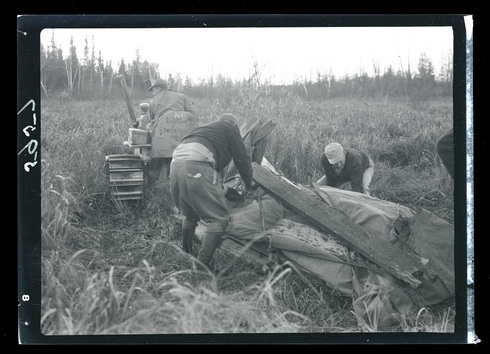
– “Getting moose for group,” 35 miles south west of Baudette, October 1944.
“… First I photographed numerous angles of the carcass and made plaster negative molds of the eye and nose before I started to skin the body. After this was completed we removed the legs and head and roughly cut off the flesh for transportation to the Museum. I carefully weighed each part and, after adding the weight of blood a veterinarian estimated totaled 1069 pounds, just a bit over a half ton. “
“In the Moose group the animal was so tall that it presented a special problem since the glass was only six feet high. The setting for this group was the soft muddy margin of the lake shore, so I actually cut off three of the feet and a portion of the legs and sank them deep into the mud with one leg lifted to show the character of the foot with its split hoof. The water surface in this group is made of several plastic sheets joined under floating branches and water lily leaves. You may not have noticed small fishes swimming in the water. “
Take a closer look at the finished Moose Diorama (completed in 1946) on the Bell Museum’s website: Moose
